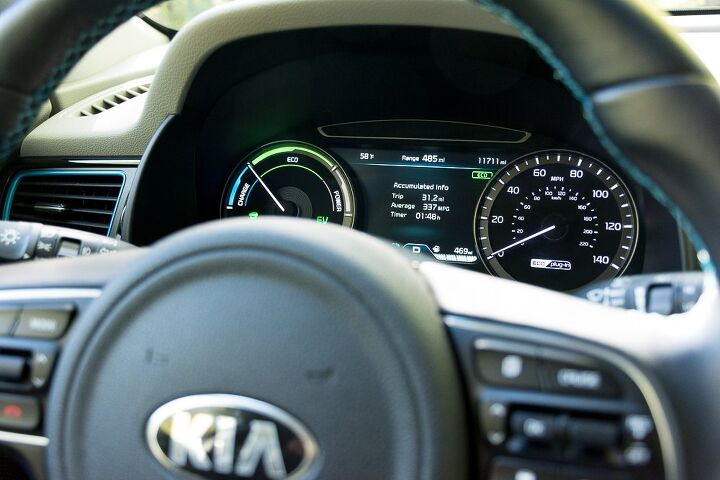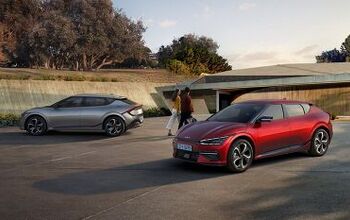At Kia, Plan B Is Called 'Plan S'

Whether you or I like it or want it, the industry is changing — pivoting towards things that cause many readers’ blood to run cold and their soul to wither and die. Futuristic things like electrification and mobility and autonomous driving. Soulless things, to some.
For most — if not all — industry players, this pivot is Plan B (Plan A being the traditional selling of internal combustion automobiles to customers who walk into dealerships). For Kia, it falls under the official title of Plan S. This week, the automaker dived into what it means for loyal customers.
In announcing details to shareholders and other money types from its Seoul home base, Kia stated the following:
By the end of 2025, Kia plans to offer a full line-up of 11 battery electric vehicles. With these models Kia is looking to achieve a 6.6% share of the global EV market (excluding China), while also attaining a 25% share of its sales from its eco-friendly cars. With the global EV market expected to gain strength by 2026, Kia is aiming for 500,000 annual EV sales and global sales of 1 million eco-friendly vehicles (excluding China).
Currently, Kia offers two fully electric models: the Niro EV and its ICE-less Soul stablemate, with hybrids starting to proliferate through the lineup. That’ll soon change, as ground-up EVs based on dedicated architecture begin showing up. The first such EV — a crossover with over 311 miles of range — launches next year, Kia claims. Bodystyles and power output will vary greatly, Kia says.
Sadly, Kia doesn’t break down the EV product mix between dedicated and derivative electric vehicles. Focusing most intensely on receptive markets, the automaker said it’s aiming for a 20-percent take rate for EVs by the middle of the decade. Emerging markets will gain whatever models Kia thinks it can actually sell.
At the same time, Kia hopes to boost sales of internal combustion vehicles, as something has to cover the bill for development of these (initially) low-margin products.
The total cost of Plan S is $25 billion by 2025, by which time Kia hopes to see a 6-percent operating margin. At the same time, the automaker plans to create “mobility hubs” in “cities with stricter environmental regulations and greater use of EVs.” Mobility services will spring forth in those areas. Looking long-term, electric and autonomous ridesharing fleets will ply roadways in those green locales.
Like plans released by other automakers, Kia’s electric ambitions hinge, in part, on a receptive buying public. Time will tell how quickly buyers pivot away from what they know and trust.
[Image: © 2018 Chris Tonn/TTAC]

More by Steph Willems
Latest Car Reviews
Read moreLatest Product Reviews
Read moreRecent Comments
- Jrhurren Worked in Detroit 18 years, live 20 minutes away. Ren Cen is a gem, but a very terrible design inside. I’m surprised GM stuck it out as long as they did there.
- Carson D I thought that this was going to be a comparison of BFGoodrich's different truck tires.
- Tassos Jong-iL North Korea is saving pokemon cards and amibos to buy GM in 10 years, we hope.
- Formula m Same as Ford, withholding billions in development because they want to rearrange the furniture.
- EV-Guy I would care more about the Detroit downtown core. Who else would possibly be able to occupy this space? GM bought this complex - correct? If they can't fill it, how do they find tenants that can? Is the plan to just tear it down and sell to developers?


































Comments
Join the conversation
"Focusing most intensely on receptive markets" Well, that's not how you grow the market share you claim to want.
Well, hedging their bets - and noting the lower margins - on electric cars and hybrids looks like a smart move. The predictions of huge sales of EVs and hybrids in the face of higher electricity prices is questionable. The transition from coal-fired powerplants to natural gas has modestly raised the cost of electricity for customers, but lowered expenses for power companies, due to the fuel being piped in, and the ability of gas fired boilers to be fired up and shut down more quickly, even though the fuel is still somewhat more costly. The potential problem with natural gas and its availability is that the huge supply that enabled power plants to switch was due to fracking. There's a strong movement against fracking, whose success would curtail electrical generation and cause skyrocketing prices. A reduced supply of electricity and a huge increase in demand for vehicle recharging looks like a disaster in the making, one that renewables will be unable to solve.